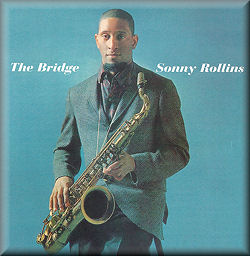1. Without a Song
2. Where Are You?
3. John S.
4. The Bridge
5. God Bless the Child
6. You Do Something to Me
7. If Ever I Would Leave You
8. The Night Has a Thousand Eyes
9. The Bridge (alternate version)
10. God Bless the Child (alternate version)
Sonny Rollins - Tenor sax
Jim Hall - Guitar
Bob Cranshaw - Bass
Ben Riley - Drums (tracks 1-4, 6-10)
Harry T. Saunders - Drums (track 5)
When I reviewed Sonny Rollins' Freedom Suite,
I wrote: "Rollins' own playing...is as inventively original as ever. Strange, then, that the year after this album was recorded, Sonny withdrew for three years from playing in public (except practising on New York's Williamsburg Bridge!), because he was unsatisfied with his playing - as well as being unhappy for other reasons".
Rollins started practising on the Williamsburg Bridge because he felt guilty about making a noise by practising at his home nearby. When he decided that he could get back into the jazz world again, RCA offered him a contract on condition that he called his first album with them "The Bridge". Thus in 1962 Sonny recorded one of his most famous albums, which has been reissued many times. This latest release adds four extra tracks, also from 1962, recorded by the same quartet. It was a pianoless group, using guitarist Jim Hall to supply the chords.
The original album consisted of six tracks, two of which were Rollins' compositions (John S. and The Bridge), while the others typified Sonny's habit of choosing popular songs rarely used in jazz, such as Without a Song and You Do Something to Me. Without a Song includes good solos from Rollins, Hall and Cranshaw (although the bass solo is marred by interruptions from the sax and guitar). Interestingly, the track ends with Sonny playing an out-of-tempo cadenza. One can imagine that this may have been how he sounded on the Williamsburg Bridge.
Where Are You? is a ballad which the quartet takes at a very leisurely pace. Rollins' John S. is unusual - not only in consisting of 34-bar choruses but in starting with a jerky musical statement which leads into Sonny's repetitive opening to his solo. Guitar, bass and drums all get solos. The structure of the title-track is also curious, consisting of choruses that are either in common time or a mixture of 6/8 and 4/4. Sonny really lets rip on this tune. The alternative version is too scrappy in the difficult opening.
God Bless the Child is presented at a slow tempo, allowing Rollins and Hall to play meditatively. Again, the alternative version seems uncoordinated. The two alternative versions were recorded at Ralph Gleason's "Jazz Casual" TV show. You Do Something to Me is taken at a comfortable bounce.
lf Ever I Would Leave You (from the musical Camelot) lasts for 12 minutes, with the rhythm section laying down a bossa nova beat. Sonny stretches out in his characteristic way, as if he could go on improvising on the tune for ever. The Night Has a Thousand Eyes clocks in at a mere nine minutes, again with a bossa rhythm. The band instinctively moves into four-four in some of the middle eights. Once more, Sonny seems inexhaustible.
If this album isn't in your collection already, it probably should be.
Tony Augarde
www.augardebooks.co.uk
